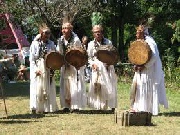




Chant and mantra are proven and time tested elements of healing with sound and music. They are essential to the healing musician’s repertoire. The more you know the more flexibility you have in the moment. Invocations are handy to have when calling in dimensional energy to assist you in your work and creations and healing practice. Intentional songs round out the palette. In this lesson we shall learn the nature of each and how to create and use them. You will also have a good start on building your personal repertoire as I will give you 12 of each category.
Mantra
A mantra is a sound, syllable, word, or group of words that is considered capable of creating spiritual transformation. Each mantra is empowered by the intention of those who have spoken it. Thus it carries a powerful energy when put into practice. Mantras originated in the Vedic traditions of India, becoming an integral part of Hinduism and Buddhism. Mantras, the Sanskrit syllables inscribed on yantras, are essentially thought forms' representing divinities or cosmic powers, which exert their influence by means of sound-
Forms of mantra in Hindu practice include Bhajan or spiritual songs; Kirtan, or the repetition of God’s name in songs; healing mantra; and Bija mantra, using the seed sounds. Each has usefulness and can be applied in your healing creations to amplify the vibration.
Often the mantras are practiced in specific ways that have transcended time. Mantra japa refers to the repetition of the mantra by chanting, speaking, whispering, mental repetition, or writing. Each mantra is recited 108 times, typically using the mala beads as a counter, at least several times each day for a period of 40 days. The more the better. Some devotees are in an almost constant state of recitation of a chosen mantra. This mantric treatment is a powerful practice that brings results. It is said that through japa the devotee attains unity, or extreme focus with the chosen deity or principal idea of the mantra. The vibrations and sounds of the mantra are considered extremely important, and thus reverberations of the sound are supposed to awaken the kundalini or spiritual life force and even stimulate chakras according to many Hindu schools of thought.
Typically the user uses one mantra at a time in devoted practice. Another mantra can be added to the practice after one has moved well into the previous mantra practice.
.
Here are some specific mantras from several different traditions (Google each for additional information)
- Om Namah Shivaya or Om Namo Bhagavate Rudraya Namah (Om and salutations to Lord Shiva)
- Om Namo Narayanaya or Om Namo Bhagavate Vasudevãya (Om and salutations to God Vishnu)
- Om Shri Ganeshaya Namah (Om and salutations to Shri Ganesha)
- Om Shri Mahalakshmiyei Namah (Om and salutations to Shri Lakshmi, the Great One)
- The Gayatri mantra is considered one of the most universal of all Hindu mantras, invoking the universal Brahman as the principle of knowledge and the illumination of the primordial Sun
Om Bhūr Bhuva Svaha (Om) Tat Savitur Varenyam Bhargo Devasya Dhīmahi Dhiyo Yo Nahah Prachodayāt, (Om)
- Om Sri Ram Jai Ram Jai Jai Ram
- Hare Krishna, Hare Krishna, Krishna Krishna, Hare Hare, Hare Rama, Hare Rama, Rama Rama, Hare Hare.
- Om tare tuttare ture svaha According to Tibetan Buddhism, this mantra can not only eliminate disease, troubles, disasters, and karma, but will also bring believers blessings, longer life, and even the wisdom to transcend one's circle of reincarnation. Tara representing long life and health.
- Om gate gate paragate parasamgate bodhi svaha The mantra of the Heart of the Perfection of Wisdom Sutra (Heart Sutra)
A current practice of these energetic times is to take traditional mantras and turn them into melodies that repeat. It is being met with mixed response as purists are outraged. Much can be said for the original frequencies of their creation. But melody allows the mantra sound to move around the body doing more expansive work. I find that people enjoy the mantra more when sung, giving them a lighter feel. Spoken mantras result in more of an altered state, a peace filled state, or a reflective state when completed. I encourage you to know both styles.
As far as creating a mantra. It can easily be done by finding sounds, words, or phrases that have specific meaning. Repetition and intention makes it a mantra. Choose specific phrases from other languages to create your mantra. Experiment with turning it into a repeating melody in a key that aligns with the purpose. Though traditional mantras are thousands of years old, there is no reason why new traditions can’t be started now.
Listen to a variety of spoken and sung mantras below. These can be the foundation of your mantric library.
Chant

Session Eight: Creation and Application of Chant, Mantra, Invocation, and Intentional Song



Session 1 l Session 2 l Session 3 l Session 4 l Session 5 l Session 6 l Session 7 l Session 8 l Session 9 l Session 10 l Session 11 l Session 12

Chant is a repetitious song designed to state an idea or to distract the mind from thinking. Chants are used to focus the mind and create a meditative, reflective, or creative state. They have been used for thousands of years in cultures all around the world. They are designed to be sung in groups as the group increases the energy and impact of the chant. Learning and creating chants can be useful to instill another way of thinking in the listener, distracting them from negative thoughts or runaway fearful thinking. A solid repertoire of chants borrows from the Native American traditions, the various world religion catalogues, the pagan practices, and world cultures: African, Celtic, Slavic, Oriental, European, Aboriginal, etc.
Chants can be any type of song or lyric. Typically, the have a statement that is recycled. It could be a phrase or it could be a verse and chorus, with both repeating. What makes chants so attractive is that they have a repeating idea. It is the repetition that helps to induce the desired state of letting go and quelling the mental chatter. You can create a chant out of an affirmative statement where it can be useful to sing when the offending thought is noticed. This process will greatly assist in eradicating the undesired thought from the sub conscious. Repetition does that.
Since many traditional mantras have been turned into song, the line between mantra and chant has blurred. Typically the chant is sung while the mantra is recited a specific number of times. The chant has melody, lyric, chordal structure, and rhythm. And the topic or focus of the chant is not restricted to spiritual ideas or deities. Chants can be made up about nature, or a situation, or an activity, or a desired outcome, or a belief.
Listen, in the player below, to a variety of chants from various sources and cultures. They represent a nice repertoire that you can learn and build upon. Of course you can write your own. Click the link below for some tips on effective chant/mantra creation. Click the other link for the lyrics and meaning of the sample chants.